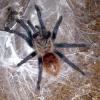I connected my Solenopsis colony of a few thousand to my Camponotus colony, which has a few hundred workers. The behaviors that followed were fascinating to observe.
As the fire ants discovered the new foraging space that was occupied by the carpenter ants, a trail was laid and fire ant workers instantly streamed into the new foraging space until the nest was nearly empty. While gaster flagging was an abundant defense, no biting/stinging of the carpenter ants was ever observed.
The carpenter ants, meanwhile, haphazardly defend their territory, with majors providing the main defense. The majors sometimes chomp at the fire ants, biting them in half. Other times, they tackle one and shoot a spray of formic acid—but the frequency of the action is intermittent at best. The carpenter ants wipe their faces on the ground when sprayed by the fire ant venom—it must be unpleasant stuff—but not a single carpenter ant falls.
There is no tangible alarm or panic on either side. As time goes on, a liquid feeder is added within the fire ant's new territory, an area about the size of a CD. The fire ants, whose army is now depleted in terms of advancement capability, struggle to hold their ground. The perimeter of the fire ant's new territory is guarded by motionless workers, gasters raised, but non-threatening. The carpenter ants continue to whittle down the fire ants, slowly, but steadily diminishing their new territory gains.
Will the fire ants retreat back to their home turf and seal off the entrance to the place that caused their defeat, or will they maintain a small presence, undeterred?
Edited by drtrmiller, February 16 2016 - 6:49 AM.




















